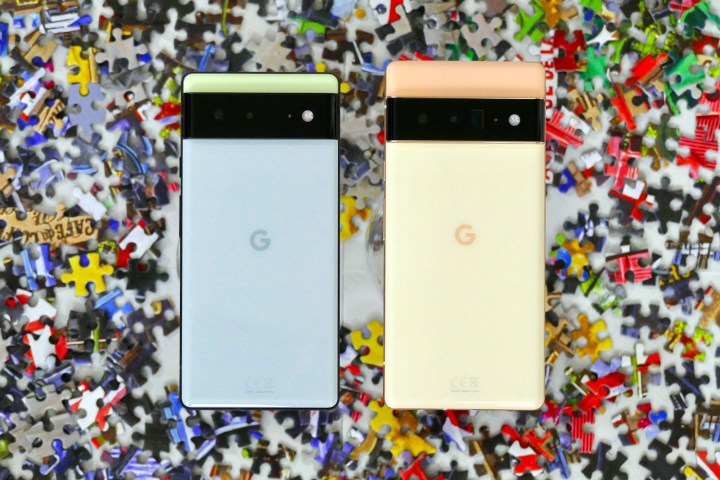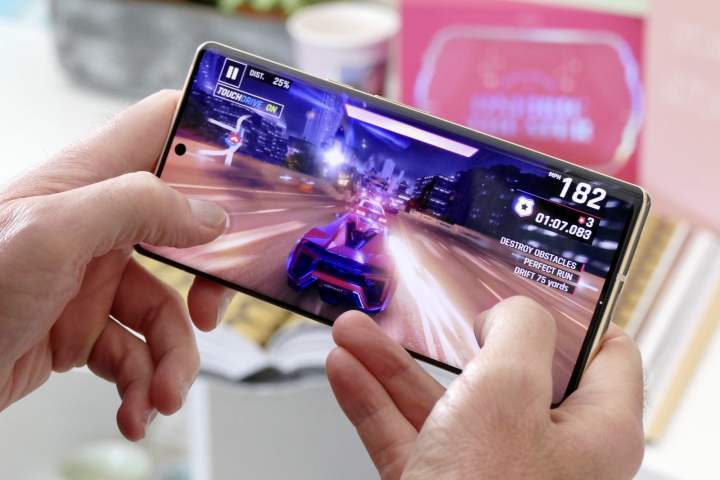It’s fair to say there are three major players in the flagship phone game at the moment — Apple, Samsung, and Google. While Google’s Pixel range doesn’t have the same mass acceptance as Apple or Samsung, it’s still putting out some exceptional devices that are finding their niche within the market. The Google Pixel 6 and Pixel 6 Pro are the newest flagship devices from the search engine giant, and they’re a big departure from the “flagship-lite” approach taken with the Pixel 5.
Loaded down with Google’s new processor technology, a unique look, and some top-quality camera smarts, the Pixel 6 and Pixel 6 Pro are some of the best flagships of the moment. But which of the two is better for you? The Pixel 6 Pro is the more advanced model, but is it worth the extra money over the base Pixel 6 model? We found out.
Specs
| Google Pixel 6 | Google Pixel 6 Pro | |
| Size | 158.6 x 74.8 x 8.9mm (6.24 x 2.94 x 0.35 inches) | 163.9 x 75.9 x 8.9mm (6.45 x 2.99 x 0.35 inches) |
| Weight | 207 grams (7.30 ounces) | 210 grams (7.41 ounces) |
| Screen size | 6.4-inch OLED with 10-90Hz | 6.7-inch OLED with 10-120Hz |
| Screen resolution | 2340 x 1080 pixels (411 ppi) | 3120 x 1440 pixels (512 ppi) |
| Operating system | Android 12 | Android 12 |
| Storage | 128GB, 256GB | 128GB, 256GB, 512GB |
| MicroSD card slot | No | No |
| Processor | Google Tensor | Google Tensor |
| RAM | 8GB | 12GB |
| Camera | Dual lens 50-megapixel wide, 12MP ultrawide rear, 8MP front | Triple lens 50MP wide, 12MP ultrawide, and 48MP telephoto rear, 11.1MP front |
| Video | 4K at up to 60 fps, 1080p at 120 fps | 4K at up to 60 fps, 1080p at 120 fps |
| Bluetooth version | Bluetooth 5.1 | Bluetooth 5.1 |
| Ports | USB-C | USB-C |
| Fingerprint sensor | Yes | Yes |
| Water resistance | IP68 | IP68 |
| Battery | 4,614mAh
30W wired charging 21W wireless charging Reverse wireless charging |
5,003mAh
30W wired charging 23W wireless charging Reverse wireless charging |
| App marketplace | Google Play Store | Google Play Store |
| Network support | Verizon, Google Fi | Verizon, Google Fi |
| Colors | Stormy Black, Kinda Coral, Sorta Seaform | Stormy Black, Cloudy White, Sorta Sunny |
| Price | Starting at $599 | Starting at $899 |
| Buy from | ||
| Review score | 4 out of 5 stars | 4 out of 5 stars |
Design, display, and durability

The Pixel 6 range has been given a big design refresh, and it’s unlikely your phone is going to be confused for any others. The big standout feature is the horizontal, visor-like camera module on the back of the phone called the “camera bar.” It’s dark, sticks out, and bisects the very top of the phone from the bottom. It’s striking and likely to divide people on whether it’s good-looking or not. The front is a more conservative affair, sporting a bezel-less design with a punch-hole for the selfie camera.
The Pixel 6 Pro is the larger of the two, with a 6.7-inch OLED display and a 120Hz refresh rate. The Pixel 6 has a smaller, 6.4-inch OLED display and supports a 90Hz refresh rate. These are two exceptional devices, though the Pixel 6 Pro’s much larger size really does mean it’s much more of a handful — and it’s slippery too. We’d definitely slap a case on it. The Pixel 6 is similarly slippery, but the smaller size means it’s much easier to handle if you have smaller hands, so that’s important to keep in mind.
We’d normally rule this in the favor of the higher refresh rate, but the Pixel 6 Pro had some issues with the higher frame rate at the time of review. Plus, it’s majorly unwieldy. With those caveats in mind, we’re changing this to a tie. They’re both gorgeous, and your choice should come down to how big a phone you can handle.
Winner: Tie
Performance, battery life, and charging

Google hasn’t just refreshed the outside of the new Pixels, it’s also made some enormous changes to the internal specs. Key to the changes is the new Google-built Tensor processor. This chip replaces the more usual Qualcomm Snapdragon processor, and it’s been created to work closely with Google’s AI models. It stacks up fine against Apple’s Bionic chip and Qualcomm’s Snapdragon in everyday use, but that doesn’t matter here. Both the Pixel 6 and Pixel 6 Pro have the same Tensor processor, so they’re going to have the same level of power.
Battery life is impressive, with both managing a good two days on a single charge, depending on whether they were heavily worked or not. Battery use will improve when the phone has taken a week or so to get used to your routine, so keep that in mind for your early days. Both will come with reverse wireless charging — so you can charge another device with your own, and with batteries this good, you might not mind doing so.
They’re neck-and-neck at this stage, but it’s worth looking at the other specs too. Neither phone has room for a microSD card, so the Pixel 6 Pro’s higher upper limit for storage wins it a point in its favor. Add the 12GB of RAM, and those with harder use will definitely favor the more expensive phone. It’s a small lead, but we’re giving it to the Pixel 6 Pro.
Winner: Google Pixel 6 Pro
Cameras

As usual, Google has thrown everything at the cameras in the new Pixel phones. Both phones have a 50-megapixel wide-angle main lens and a 12MP ultrawide lens to back it up. The Pixel 6 Pro goes one further, though, packing a 48MP telephoto lens. The Pixel 6 Pro’s telephoto lens is also a periscope lens, which means it lays lengthways down the body, allowing for a much larger zoom than would otherwise be available.
Everything you’ve heard about the Pixel 6 and Pixel 6 Pro’s cameras is true — they’re exceptional. Both are loaded down with features like the Magic Eraser mode that removes objects from your photos, the Motion Mode that takes cool shots of moving cars or subway trains, and Face Unblur, which takes multiple pictures to unblur faces. But the star of the show is the camera app’s optimizations. Simply put, both phones have excellent point-and-shoot capabilities, and you rarely need to make any tweaks to an image after it’s taken.
But which is better? The Pixel 6 Pro, for sure. It’s the more consistently great of the two, and the one you should buy if you’re really into your smartphone photography. The Pixel 6 is still amazing, it’s just not quite as good.
Winner: Google Pixel 6 Pro
Software and updates

Both of these phones have Android 12, and thanks to the new Tensor chip, get updates for even longer than previous Pixel phones. That’s because Google is no longer tethered to the whims of processor manufacturers (who largely decide which of their processors will update to new Android updates). By creating its own chips, Google has now entered the same space as Apple, which can support devices for much longer than normal.
These two phones will get the same updates at about the same time for the same period. This is an absolute draw.
Winner: Tie
Special features

Google’s focus, as usual, is on its Google AI, so it’s no surprise the new Tensor chip is being used to supercharge the Pixel 6 and Pixel 6 Pro’s capabilities. The camera gets the majority of these improvements, of course, but expect to see improvements elsewhere as well as snappier (and better) responses from the Google Assistant.
Aside from this, the Tensor chip also powers the Titan M2 security coprocessor. Google claims this has made the new Pixels the most secure devices in the world, making these phones worth considering if security is a priority. Throw in Google’s fun augmented reality features, and you’ve got two phones fairly packed full of special features. But there’s little to separate them here. It’s another tie.
Winner: Tie
Price and availability
The Google Pixel 6 and Pixel 6 Pro are currently available to buy. The Pixel 6 starts at $599, while the Pixel 6 Pro starts at $899. Both are available from a variety of retailers and across all major U.S. carriers.
Overall winner: Google Pixel 6 Pro
It had to be: The Pixel 6 Pro has triumphed over its cheaper stablemate. The extra storage option and extra camera lens turned out to be the most important elements in its victory, making the Pro model the one to buy if price is no object.
But really, look at how little separates the two. There are an awful lot of draws up there, and while the Pixel 6 Pro is the stronger of the two, the Pixel 6 is clearly an excellent smartphone with a lot to offer. If an extra camera lens and 120Hz display don’t ignite your fire, the Pixel 6 is a real steal at $599. It packs in an incredible camera, the same processor, and a 90Hz refresh rate, and saves you $300 as well.